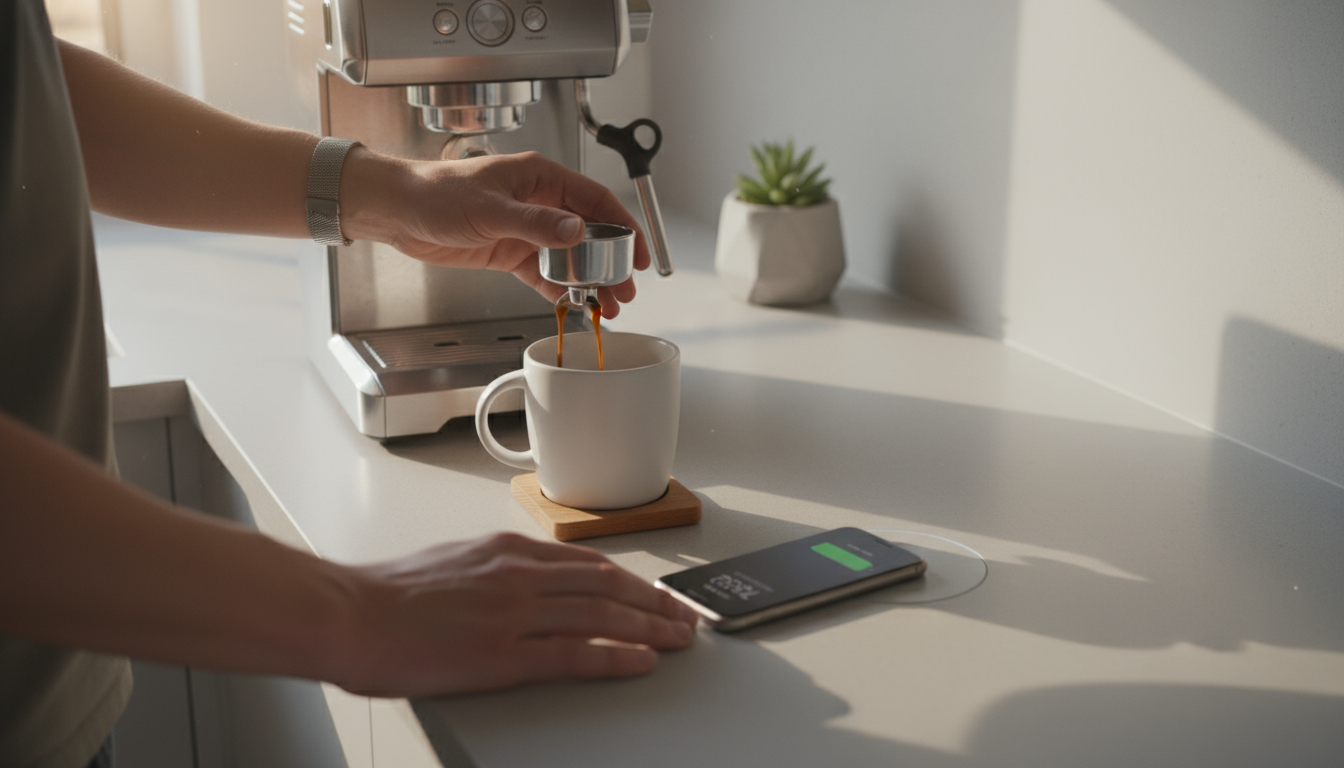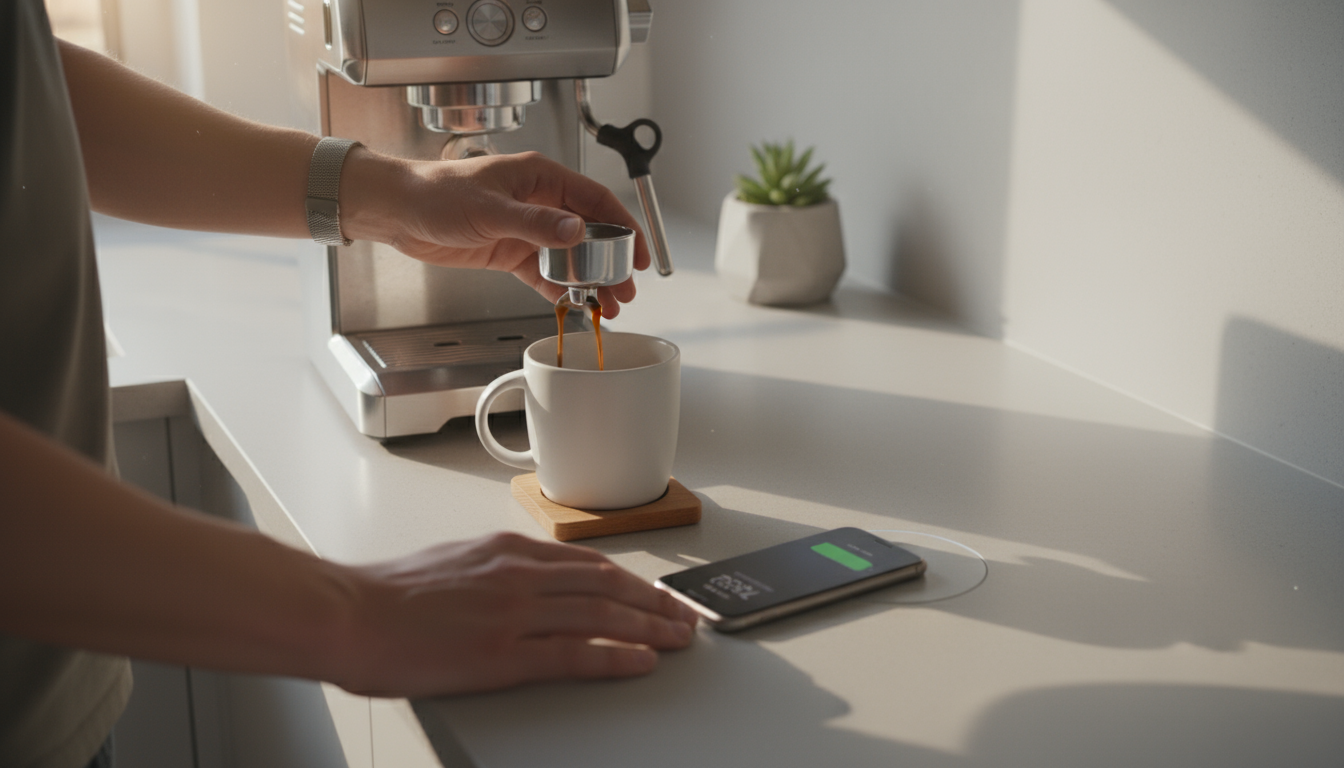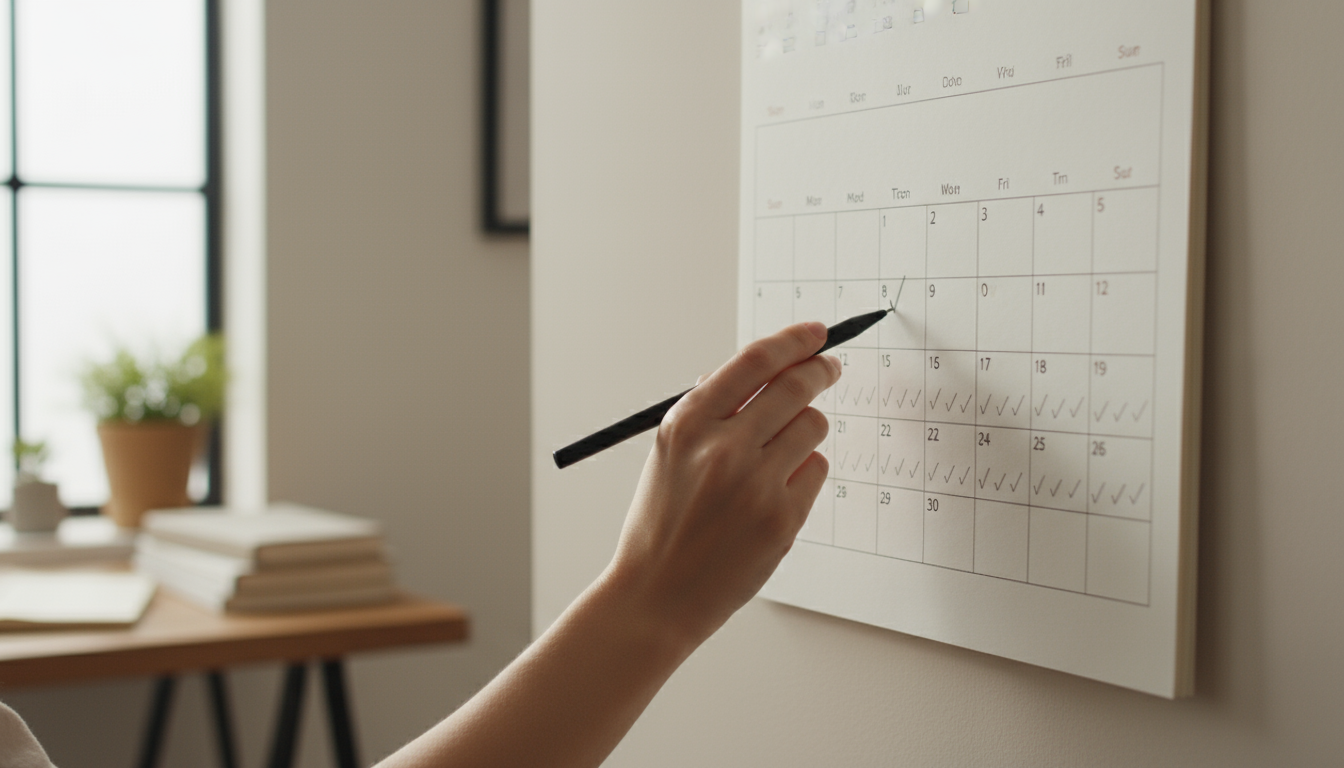
If you live and work in a busy, modern world, you know the feeling. Your day starts with a plan to be focused and productive, but by 10 AM, you’re pulled in a dozen different directions. Notifications buzz, emails pile up, and the constant hum of the city seeps into your concentration. In these moments, we’re often told to just “try harder” or “be more disciplined.” We summon our willpower, clench our jaws, and try to force our minds to comply. But willpower is like a muscle; it gets tired. For those of us navigating the relentless demands of urban life, relying on it alone is a recipe for burnout.
What if there were a gentler, more sustainable way to cultivate focus? What if, instead of fighting against distraction, you could train your brain to find a calmer, more centered state from which focus naturally emerges? This is the promise of a simple gratitude habit. It’s not another demanding item on your to-do list or a complex wellness ritual. It’s a quiet practice, built with tiny, consistent steps, that fundamentally changes your brain’s relationship with the world. It shifts your default setting from seeking threats and distractions to noticing opportunities and resources.
This article will guide you through the process of building a durable gratitude habit, not through force, but through thoughtful design. We’ll explore the science of how habits form, how to create a practice so small it’s impossible to skip, and how this simple act can have profound effects on your ability to concentrate. The goal isn’t perfection; it’s gentle consistency. Forget willpower. It’s time to discover how gratitude helps focus, one small, intentional thought at a time.
📚 Table of Contents
- Understanding the Mechanics of a Lasting Habit
- Designing Your Gratitude Habit for Success
- Start with a Minimum Viable Action
- Conduct a Friction Audit
- Use Your Environment as a Cue
- The Role of Gentle Accountability
- Safeguarding Your Habit from Life’s Interruptions
- Planning for a Relapse: The “If-Then” Strategy
- Escaping the Trap of the Streak
- How to Reset Without Shame
- Putting It All Together: Two Sample Gratitude Routines
- Frequently Asked Questions About the Gratitude Habit
- How long does it really take to form a gratitude habit?
- What should I do on busy days or when I’m traveling?
- I feel like I’m just listing the same things. How do I avoid a gratitude plateau?
- Can I combine this with other goals like meditation or journaling?
- How exactly does a gratitude habit help with focus?
- Your First Steps to Building a Gratitude Habit
Understanding the Mechanics of a Lasting Habit
Before we can build a new habit, it’s helpful to understand how they work under the hood. So often, we try to install a new behavior using sheer enthusiasm, but when that initial motivation fades, the habit crumbles. A lasting habit isn’t built on inspiration; it’s built on a reliable, automated loop that your brain learns to follow. By understanding this structure, you can design a gratitude practice that works with your brain’s natural tendencies, not against them.
There are two core concepts that will transform your approach: the simple, three-part habit loop and the powerful idea of identity-based habits. Together, they form the foundation for creating a behavior that feels less like a chore and more like a natural part of who you are.
The Habit Loop: Cue, Action, Reward
At its core, every habit, good or bad, follows a simple neurological pattern that we can call the habit loop. It consists of three parts: a cue, an action, and a reward. Understanding this loop is the first step to consciously designing a new habit like gratitude.
First, there’s the cue. This is the trigger, the thing in your environment or your internal state that tells your brain to initiate the habit. It could be a time of day (7 AM), a place (your kitchen), a preceding event (finishing your workout), or an emotional state (feeling stressed). For an unwanted habit, the cue for reaching for your phone might be the feeling of boredom.
Next comes the action, also known as the routine. This is the behavior itself. It’s the thing you actually do. It could be brewing a cup of coffee, lacing up your running shoes, or, in our case, thinking of something you’re grateful for. The action is the most obvious part of the habit, but it’s only one piece of the puzzle.
Finally, and most importantly, there’s the reward. The reward is the positive feeling or outcome that your brain gets from completing the action. This is what tells your brain, “Hey, that was good. Let’s remember this loop for next time.” For the coffee habit, the reward might be the taste, the warmth, or the caffeine boost. The reward is what closes the loop and makes the behavior more likely to become automatic in the future. For a gratitude habit, the reward is often a feeling of calm, perspective, or a gentle uplift in mood.
Beyond Actions: The Power of Identity-Based Habits
While the habit loop explains the “how” of a habit, focusing on your identity explains the “why.” This is a crucial distinction that separates habits that stick from those that don’t. Most people start with an outcome-based goal: “I want to lose 20 pounds” or “I want to write a 500-page book.” These are fine goals, but they aren’t great for building habits.
Identity-based habits, on the other hand, focus on who you want to become. Instead of saying, “I want to write in a gratitude journal every day” (an outcome), you shift your focus to, “I want to be a grateful person” (an identity). Every time you perform your small gratitude action, you are casting a vote for that new identity. You are reinforcing the belief that you are that kind of person.
Why is this so much more powerful? Because our behaviors tend to align with our identity. When your habit is tied to your sense of self, it becomes intrinsically motivated. You’re no longer just checking a box; you’re being who you want to be. The small win of thinking of one good thing isn’t just an action; it’s evidence that you are a person who finds the good in their day. This shift from “having to do” something to “getting to be” someone provides a deep, internal motivation that willpower can never match. As we design your gratitude habit, keep this question in mind: What kind of person do I want to become?

Designing Your Gratitude Habit for Success
Now that we understand the underlying model of the habit loop and the power of identity, we can move from theory to practice. This is the design phase, where we architect a gratitude habit that is not only effective but also resilient and forgiving. The goal is to make the right choice the easy choice. We’ll achieve this by starting impossibly small, removing hidden obstacles, and cleverly linking our new habit to our existing daily life. This isn’t about finding more time or energy; it’s about being smarter with the time and energy you already have.
Start with a Minimum Viable Action
One of the biggest mistakes we make when starting a new habit is making it too big. We declare, “I’m going to write three full pages in my gratitude journal every single night!” While admirable, this sets a high bar for success. On a busy or tiring day, that task can seem monumental, making it easy to skip. And once you skip it, it’s easier to skip it again.
The solution is to define a minimum viable action (MVA). This is the smallest possible version of your habit, an action so easy and quick that you have no excuse to skip it, even on your worst day. Your MVA should take less than two minutes to complete. For a gratitude habit, your MVA isn’t writing three pages; it’s writing one sentence. Or even simpler: it’s just thinking of one specific thing you’re grateful for. Can you do that? Of course, you can. It’s too small to fail.
Starting with an MVA builds momentum. Every time you complete it, you reinforce the habit loop and cast a vote for your new identity as a grateful person. You can always do more—if you feel inspired to write a whole page, fantastic!—but the MVA is your minimum standard for success. It ensures you never have a “zero day,” which is critical for long-term consistency.
Conduct a Friction Audit
Every action we take has a certain amount of friction associated with it. Friction is any force that makes a behavior more difficult. It’s the collection of small obstacles that stand between you and doing the thing you want to do. For an evening journaling habit, friction could be that your journal is on a bookshelf in another room, you can’t find a pen, or your nightstand is too cluttered. Each of these tiny hassles increases the effort required and makes you less likely to follow through.
A friction audit is the process of identifying and systematically removing these obstacles for your desired habits, while simultaneously adding friction to habits you want to break. To design your gratitude habit, ask yourself: “What are all the tiny things that could get in the way of me doing my MVA?” Then, solve them in advance. If your MVA is to write one sentence, put a notepad and a pen directly on your pillow in the morning. If it’s to think of one thing while your coffee brews, put a sticky note on your coffee machine that says, “One good thing?” By reducing friction, you make your gratitude habit the path of least resistance.
Use Your Environment as a Cue
Your environment is one of the most powerful and overlooked drivers of your behavior. We can leverage this by intentionally designing our surroundings to cue our desired habits. This brings us back to the first step of the habit loop: the cue. Instead of waiting for a random reminder, we can create an explicit one. A sticky note is a simple example, but an even more effective technique is known as habit stacking.
Habit stacking involves linking your new, desired habit to a pre-existing, firmly established one. The old habit becomes the cue for the new one. The formula is simple: “After I [current habit], I will [new habit].” You already have dozens of strong habits you perform every day without thinking: brushing your teeth, putting on your shoes, pouring your morning coffee, getting into bed. These are perfect anchors for your new gratitude habit.
For example: “After I set my morning coffee on my desk, I will think of one thing I’m grateful for today.” Or, “After my head hits the pillow at night, I will mentally review one good moment from the day.” By piggybacking on an existing neural pathway, you’re not starting from scratch. You’re simply adding a small extension to a road your brain already travels daily. This makes the new habit feel less like a separate task and more like a natural part of your existing flow.
The Role of Gentle Accountability
Accountability can be a powerful tool, but it often gets a bad rap. We associate it with pressure, judgment, and failure. For a gentle habit like gratitude, we need a gentle form of accountability. The purpose isn’t to punish you for missing a day but to kindly remind you of your intention. The simplest form of this is a habit tracker. This could be a calendar on your wall where you make a small checkmark each day you complete your MVA. Seeing the chain of checkmarks grow can be incredibly motivating.
However, it’s crucial to use this tool correctly. The goal isn’t an unbroken chain; it’s a consistent effort. Another form of gentle accountability is simply telling a supportive friend about your intention. You might say, “I’m trying to build a small gratitude habit to help with my focus. I’m just starting by thinking of one thing a day.” You don’t even need them to check in on you; the simple act of stating your intention out loud can make it more real and increase your commitment. Remember, this is about support, not surveillance. Choose a method that feels encouraging, not stressful.

Safeguarding Your Habit from Life’s Interruptions
No matter how well you design your habit, life will inevitably get in the way. You’ll have a stressful day, travel will disrupt your routine, or you’ll simply forget. This is not a sign of failure; it is a normal, expected part of the process. The difference between someone who builds a lasting habit and someone who doesn’t is not their ability to be perfect. It’s their ability to get back on track quickly and compassionately after a misstep. This section is about creating safeguards—your plan for when things don’t go according to plan.
Planning for a Relapse: The “If-Then” Strategy
A “relapse” sounds dramatic, but in this context, it just means missing a day of your habit. It’s going to happen. Instead of being surprised by it, we can plan for it. A powerful psychological tool for this is the “if-then” plan, also known as an implementation intention. You proactively decide how you will respond when you encounter a specific obstacle.
The structure is straightforward: “If [obstacle occurs], then I will [do this action].” For your gratitude habit, this might look like: “If I get into bed and realize I forgot to do my gratitude practice, then I will simply think of one thing right then and there.” Or, “If I have an incredibly busy day and miss my morning cue, then I will take 30 seconds to think of something I’m grateful for while I’m waiting for the elevator.”
By creating this plan in advance, you remove the need to make a decision in a moment of fatigue or frustration. You’ve already told your brain what to do. This transforms a missed habit from a moment of failure into a simple trigger for a pre-planned backup action. It keeps one missed day from turning into two, which is the most important rule of habit building.




Escaping the Trap of the Streak
Habit-tracking apps and calendars have made “the streak” a popular motivational tool. Seeing a long chain of successes—50, 100, 200 days in a row—can feel amazing. It provides tangible proof of your commitment. However, the streak has a dark side. It creates a mindset of perfectionism. The longer the streak gets, the more pressure you feel not to break it. And when you inevitably do miss a day, the psychological crash can be devastating. For many, breaking a 150-day streak feels like a total failure, causing them to abandon the habit altogether.
A healthier, more resilient mindset is to follow the rule: never miss twice. Missing one day is an accident. Missing two days is the beginning of a new, unwanted habit. This re-frames the goal from “never fail” to “get back on track immediately.” It allows for the reality of human imperfection. If you miss a day, your sole focus for the next day is to simply do your minimum viable action. That’s it. This approach values consistency over intensity and resilience over perfection, which are the true keys to long-term success with any habit, including exploring gratitude habit benefits.
How to Reset Without Shame
When you do miss a day, your internal critic might show up. It might say, “See? You can’t even stick with this simple thing. You’re just not a focused or grateful person.” This kind of self-talk is the enemy of progress. Shame is not a sustainable motivator. The antidote is self-compassion.
Learning how to reset without shame is a skill in itself. It involves a simple, three-step internal script. First, acknowledge what happened without judgment: “Okay, I missed my gratitude practice yesterday.” Second, reaffirm your identity: “That’s okay. I am still a person who is building a habit of gratitude and focus.” Third, take immediate, small action: “I’m going to do my MVA right now.”
This process takes the emotional charge out of the situation. It treats the missed day as a piece of data, not a moral failing. It reminds you that one event doesn’t define your identity. By practicing this gentle reset, you not only protect your gratitude habit, but you also build the meta-skill of self-compassion, which is essential for any meaningful, long-term behavior change.

Putting It All Together: Two Sample Gratitude Routines
Theory is one thing, but seeing how these principles work in the rhythm of a real day can make them much clearer. Let’s walk through two detailed examples of how someone might design and implement a gratitude habit. Notice how each routine incorporates a clear cue, a minimum viable action, friction reduction, and a connection to identity. These are not rigid prescriptions, but illustrations to inspire your own personalized design.
An Evening Wind-Down Routine
Imagine Sarah, a project manager who struggles to switch off her work brain at night. Her goal is to create a sense of closure and calm before sleep, so she decides to build an identity as “someone who ends the day peacefully.” She chooses an evening gratitude habit to help with this.
First, she designs her habit stack. Her cue is an action she already does without fail: getting into bed and turning off her main bedroom light. Her habit stack becomes: “After I turn off the light, I will write down one good thing from the day.” To reduce friction, she places a small, dedicated notepad and her favorite pen on her nightstand, right next to her lamp. There’s nothing else there; it’s clear and ready for action. Her minimum viable action is to write just one specific sentence. For example, not just “I’m grateful for my team,” but “I’m grateful for the way John helped me solve that coding bug this afternoon, which made me feel supported.”
As she writes her sentence in the soft glow of her bedside lamp, she feels a subtle but distinct reward: a sense of accomplishment and a gentle emotional shift away from the day’s stresses. She is actively focusing her mind on a positive, concrete memory. This small act serves as a buffer between the chaos of her workday and the restfulness of sleep. Each night she does this, she’s not just checking a box. She is casting a vote for her identity as a calm and grateful person, making it easier to show up that way the next day. This simple routine directly addresses how gratitude helps focus by calming the mind for restorative sleep, which is critical for next-day concentration.
A Morning Focus Primer Routine
Now consider David, a freelance writer who often starts his day feeling overwhelmed by his project list. His goal is to begin his workday with a sense of clarity and purpose. He wants to build an identity as “a writer who starts his work with calm intention.” He decides a morning gratitude habit could prime his brain for focus.
David’s strongest existing habit is making his pour-over coffee every morning. This becomes his cue. His habit stack is: “While I wait for the water to drain through my coffee, I will think of three things I’m grateful for related to my work.” This specificity is key. It directly ties the gratitude practice to his goal of better focus. To reduce friction, he places a small, laminated card next to his coffee station that simply says, “Three work-related things.” This visual cue prevents him from forgetting.
His MVA is to mentally name three things. On a good day, he might think, “I’m grateful for the new client contract that came through, for the clear feedback on my last draft, and for the quiet apartment that allows me to think.” On a tough day, it might be simpler: “I’m grateful I have a computer that works, coffee to drink, and one hour of time to write.” The reward is immediate. Instead of starting his day from a place of deficit (“I have so much to do”), he starts from a place of resourcefulness (“I have what I need to begin”). This gratitude habit benefits his entire workday by setting a positive, focused tone from the very first minute, directly combating the sense of overwhelm that so often kills productivity.

Frequently Asked Questions About the Gratitude Habit
As you begin to build your own gratitude habit, questions will naturally arise. This is a great sign—it means you’re engaged in the process. Here are answers to some of the most common questions we hear. The goal is to provide clarity and support, helping you navigate the nuances of creating a practice that truly works for you.
How long does it really take to form a gratitude habit?
You may have heard the popular myth that it takes 21 days to form a habit. While a nice, simple number, research shows it’s more complicated than that. The time it takes for a habit to become automatic can range from a couple of weeks to many months, depending on the complexity of the behavior and the individual. Instead of focusing on a magic number of days, it’s more helpful to focus on consistency and automaticity. Is the behavior getting easier? Do you find yourself doing it with less and less conscious thought? That’s the real sign of progress. The key is to release the pressure of a deadline and focus on the process of showing up each day. The study of neuroplasticity suggests that consistent practice gradually strengthens neural pathways, and you can find general information on this from leading institutions like the National Institutes of Health.
What should I do on busy days or when I’m traveling?
This is where your minimum viable action (MVA) becomes your superpower. On a perfect day, you might have time to journal thoughtfully. On a chaotic travel day or when you’re overwhelmed with deadlines, you revert to your MVA. If your MVA is to “think of one thing you’re grateful for,” you can do that anywhere, anytime. You can do it in an airport security line, in a taxi, or in the two minutes before a big meeting. The goal on these days isn’t depth; it’s consistency. By completing your MVA, you keep the chain of your habit alive and maintain your identity as a person who practices gratitude, even when circumstances are challenging. It reinforces that the habit is adaptable and not a fragile routine that shatters at the first sign of disruption.
I feel like I’m just listing the same things. How do I avoid a gratitude plateau?
This is a very common experience. At first, it’s easy to list the big things: your family, your health, your job. But over time, this can feel repetitive and lose its impact. The solution is to increase the specificity. Instead of “I’m grateful for my partner,” try “I’m grateful for the way my partner made me laugh by telling that silly joke during dinner.” Instead of “I’m grateful for my coffee,” try “I’m grateful for the rich smell of the coffee beans this morning and the warmth of the mug in my hands.” By focusing on a specific moment, a sensory detail, or a unique interaction, you force your brain to actively scan your day for fresh evidence of goodness. This keeps the practice engaging and deepens its effect on your awareness.



Can I combine this with other goals like meditation or journaling?
Absolutely, and habit stacking is the perfect tool for this. You could, for example, create a routine that goes: “After I finish my one-sentence gratitude entry, I will open my meditation app.” However, a word of caution: it’s generally best to focus on establishing one new habit at a time. Trying to build a gratitude habit, a meditation habit, and a workout habit all at once can lead to overwhelm and cause you to abandon all of them. A better approach is to master one MVA first. Once your gratitude habit feels easy and automatic, then you can stack the next habit on top of it. Build your foundation one brick at a time.
How exactly does a gratitude habit help with focus?
This is the core question, and the connection is both direct and indirect. First, practicing gratitude is a form of mental training. It teaches your brain to actively seek out positive information, strengthening your attentional control. Second, it acts as an emotional regulator. When you’re feeling anxious or ruminating on a negative event, your cognitive resources are drained. A moment of gratitude can interrupt that negative loop, calming your nervous system and freeing up mental bandwidth. This creates a more stable emotional baseline, which is essential for deep work. Think of it as clearing the mental clutter so you can see the task at hand more clearly. For more on the relationship between emotional states and cognitive performance, you can explore resources from organizations like the American Psychological Association.

Your First Steps to Building a Gratitude Habit
We’ve covered the why, the how, and the what-ifs of building a simple habit of gratitude to improve your focus. We’ve learned that it’s not about grand gestures or superhuman willpower. It’s about small, intelligent design, gentle consistency, and self-compassion. The incredible benefits of a gratitude habit are not reserved for a select few; they are available to anyone willing to start small and stay with the process.
The journey of a thousand miles begins with a single step. Your journey to a more focused and intentional life can begin right now, with a few simple, concrete actions. Here is your plan for the next month. Don’t feel pressured to perfect it; just commit to starting it.
Your Mission for the Next 24 Hours
Your only task for today is to decide on your minimum viable action (MVA). What is the absolute smallest, easiest version of a gratitude practice you can imagine? Will you think of one thing? Say it out loud? Write one word on a sticky note? Choose an action so simple it feels almost silly. Write it down on a piece of paper. This is your foundation. Congratulations, you’ve already taken the most important step.
Your Mission for the Next 7 Days
This week, your goal is to design your cue. Using the principle of habit stacking, identify a strong, existing habit that will serve as the trigger for your gratitude MVA. Will it be after you brush your teeth? After you pour your coffee? After you put your keys in the bowl by the door? Choose one. Then, set up your environment for success. Place a physical reminder at the location of your cue—a note, a special object, or your journal. For the next seven days, simply focus on performing your MVA immediately after your cue. Don’t worry about how you feel or if it’s “working.” Just build the link between the cue and the action.
Your Mission for the Next 30 Days
Over the next month, your primary goal is to practice consistency and self-compassion. Your mantra is “never miss twice.” You will inevitably have a day where you forget or are too exhausted. That’s okay. When it happens, don’t analyze it or beat yourself up. The very next day, make it your number one priority to complete your MVA. This month is about proving to yourself that you can get back on track. It’s about building resilience, not a perfect record. By the end of 30 days of this gentle practice, you won’t just have a new habit; you’ll have a new, more compassionate and effective way of approaching personal growth.
Disclaimer
The information provided in this article is for educational and informational purposes only and is not intended as a substitute for advice from your physician or other qualified health care professional. You should not use the information on this site for diagnosis or treatment of any health problem. Always speak with a healthcare professional before starting any new behavior change program or if you have or suspect you might have a health problem.






